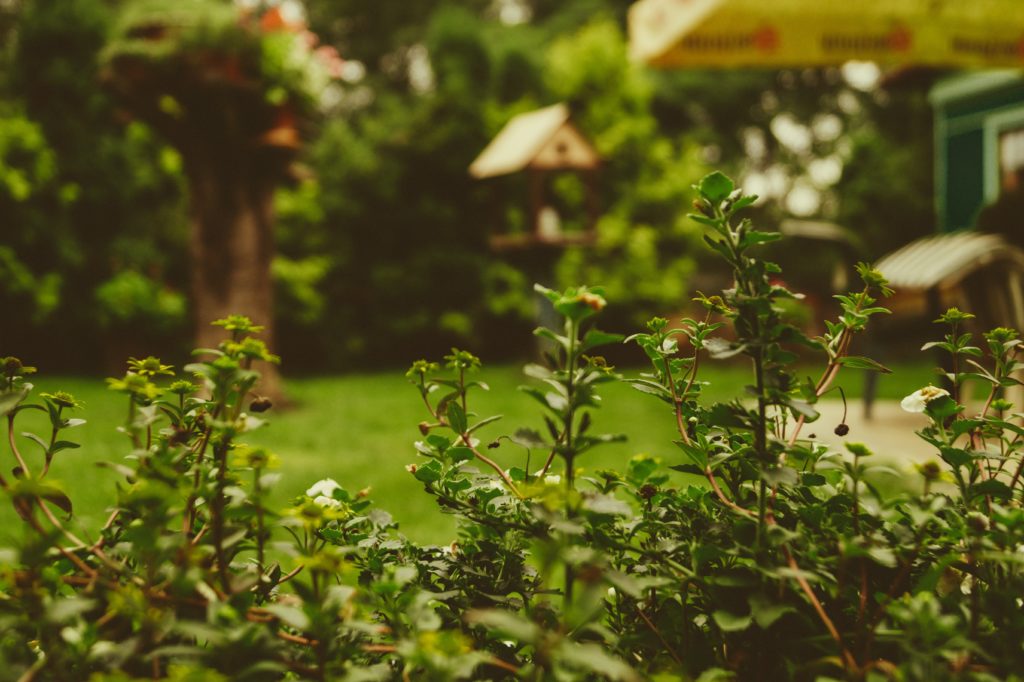
According to outdoor landscaping experts, a well-maintained landscape design is beneficial for many reasons, not the least of which is the first impression of a home that it almost single-handedly controls. Something as simple as an unmowed yard can make a home appear messy or neglected, even if every other part of the landscape is clean. Yet despite that, exterior landscaping is still ignored by many homeowners.
Whether these homeowners are deterred by the fear that they lack the skill needed to do a job or by fear of being stuck paying for an expensive project they can’t afford, the fact is they are doing themselves and their home a bit of a disservice.
Benefits of Well-Maintained Landscaping: A Quick Look
Studies have shown that just the act of looking at plants and trees has stress and blood pressure-lowering abilities. Taking that looking a step further and turning it into gardening can have the added benefits of boosting your immune system, helping with addiction recovery, and fostering a feeling of connectedness.
It can even lead to mental clarity and feeling a sense of purpose.
Most people invest the time and effort into maintaining their landscaping because it increases the value of the property, which is particularly desirable to anyone buying or selling a home. And at the end of the day, regardless of buying, selling, or any other benefits, it just plain looks good.
Depending on the size of your landscape design and its condition, knowing where to start isn’t always straightforward. Landscaping can be a bit of a subjective art form from a creative point of view; however, most outdoor landscaping experts will agree on the potential problem areas and the outdoor solutions that every homeowner should ensure they’re doing.
So, this is where you start. These are the 10 projects that outdoor landscaping experts say are the best outdoor solutions to whatever sort of problem you may encounter. Some of the projects may seem basic or obvious. That is because a healthy, sustainable landscape is not possible without first building the foundation that will support all the different organisms and processes as they work together.
All of these things can take any part of any landscape design and make it functional, safe, and beautiful.
1. Relocate or remove any trees causing any visible damage
Trees are not a part of every home’s landscape design, but when they are, they are the most valuable asset. If you have a yard full of healthy, beautiful, mature trees, you’re sitting on a small fortune.
Most DIY gardeners and even outdoor landscaping experts buy trees in 15-gallon or 24″ box size. 36″ boxes aren’t uncommon if they’re feeling spendy. But you can go upwards of 60″ or 72″ boxes, and when you do, you’re looking at possibly thousands of dollars per tree just to buy them, depending on the species.
Monetary value aside, their location in the yard relative to sun exposure, rooflines, windows, foundations, walkways/pathways, and any underground lines – not to mention existing landscaping – is hugely important. Most outdoor landscaping experts will tell you that there’s a science to tree placement; not everyone applies it, but they should.
Preemptively moving or removing an established tree does not fall under the category of viable outdoor solutions because you never know for sure, and it’s not worth the risk of death when you don’t know for sure. If you do start to see any visible damage, plan to have the tree transplanted or removed. The damage will only get worse.
Relocations are the preferred choice as you always want to save the tree whenever possible. Most outdoor landscaping experts will have you sign a waiver absolving them of any responsibility if the tree does not survive. Transplants are a gamble and cannot be guaranteed.
If a full removal is needed, consider the landscape design and whether stump grinding or a complete root ball extraction is best. Stump grinding is usually cheaper. Both are good outdoor solutions depending on your specific needs.
2. Tree trimming – perform structural pruning and crown-thinning
Tree trimming is needed at least one time per year, maybe more depending on where you live, species of tree(s), and rate of growth. Structural pruning maintains the architectural integrity of the tree’s natural shape and growth pattern. It includes removal of cross limbs and anything potentially dangerous, along with anything else that does not enhance the tree’s natural beauty.
Crown-thinning focuses more on clearing excess foliage adding unnecessary weight. If canopies are already in or getting close to overhead power lines or rooflines, consider doing this right away.
If your trees are overgrown even by one season, or you live in an area prone to inclement weather such as monsoons, microbursts, or heavy winds, structural pruning and crown-thinning will prevent future property damage and potentially the life of the tree.
Many outdoor landscaping experts are also certified arborists. If they are not, they typically employ one or have one they use as a sub-contractor.
3. Hook up a xeriscape-friendly drip irrigation system
Don’t let the phrase “irrigation system” scare you. These days there are low volume options that are easy to install into any landscape design while being very budget-friendly. Work with your outdoor landscaping experts to come up with the best layout for your existing landscape design.
A low-volume drip irrigation system is one of the most efficient outdoor solutions because even if you are hand-watering – especially in that case – an automated system that focuses low-volume output right into the plants’ root zone is going to save water. And as we know, saving water means saving dollars.
In addition, your plants will be healthier, erosion issues are less likely, and you’re reducing the risk of diseases spreading by keeping the foliage dry.
4. Use native or acclimated plant material, remove any that is not
A thriving landscape design includes plants that are either native/indigenous or acclimated to the local climate. Sure, it may be fun and challenging to try and grow rare exotics; ultimately, they are often not worth the added maintenance and resources.
A landscape in a hot, dry climate should consist of plants that do not consume too much water. On the other hand, climates with heavy rainfall require plants that can handle wet conditions. Makes sense, right? In either case, your palette should be planted out in groupings that consume about the same amount.
The plant material should also tolerate the winter and summer temperatures without issue. Make sure you don’t have species that can grow too large and overtake other species.
If you have turf, the same rules apply: choose a locally grown variety that is known to do well in the area. That will keep you – or future homeowners if you’re planning to sell – from having to deal with high maintenance needs or outright death.
As an example, growing papayas may sound like delicious fun, but they will not tolerate freezing temperatures. One of several outdoor solutions to that problem could be swapping out for more area-appropriate fruit trees such as peach, pear, or plum – just as delicious, and just as fun.
Outdoor landscaping experts can make recommendations for plants and trees that will thrive in the general local climate, and in your own microclimate. They can also assist if needed with removing and responsibly disposing of anything that does not belong.
5. Repair any issues with drainage, run-off, or standing water
There’s nothing better than ice-cold water with a slice of cucumber or citrus on a hot day. It sustains all life. Its presence in a water feature can create a Zen garden type effect that is mentally calming. Water is a beautiful thing.
But there are cases when its presence can be a bad thing. In those cases, eradication is the top priority. We’re talking about drainage issues, excessive run-off, and standing water.
- drainage issues: slope or pitch problems in the earth that keep the water from going to and collecting in a safe place, or overflowing gutters and downspouts that don’t pipe the rain gutters far enough away; this will also cause and therefore goes hand-in-hand with erosion
- excessive run-off: what happens when the soil is unable to hold any more moisture; this will also cause erosion
- standing water: any area of your yard that cannot fully dry out when adjacent areas can; happens when the water has nowhere to drain to
The best cure for any drainage issue is prevention, which is why thorough and knowledgeable landscape design is so important. If prevention is not an option, perform the repair as soon as possible. The problem will worsen quickly and will start to attract pests as well (like mosquitoes, as an example).
Dry creek beds and French drains are just two outdoor solutions perfect for repairing drainage issues.
6. Be mindful of environmental causes and initiatives
If the design or palette of the existing landscape is heavy on precious resources or does not make the best use of other resources, plan to perform a conversion to a design that takes nature and the needs of the environment into consideration.
For example, drainage or standing water issues are perfect candidates for outdoor solutions involving rainscaping or rainwater harvesting. For those who may not know, rainscaping is an environmentally conscious concept of design and maintenance that saves our natural bodies of water from being contaminated by polluted run-off. To be successful, it must start in the communities, with the homeowners.
Outdoor landscaping experts can provide you with landscape design options that implement rainscaping.
7. Dethatch or aerate your lawn
Though similar and often done in conjunction, dethatching and aerating are two different processes that accomplish different things.
- dethatching: removal via hand-rake or mechanized dethatching rake of the layer of organic material that has accumulated and rests on top of the grass
- this layer acts as a barrier between the living stems and the roots (the material is usually a mix of old grass clippings from mowing, fallen leaves from trees, and any other debris); when this debris accumulates faster than it can decompose, it creates a “thatch”
- a thin layer of thatch isn’t a bad thing as it can preserve moisture in the soil and act as a protective barrier; too much thatch prevents air, water, and other nutrients from getting to the roots
- aerating: using a piece of power equipment called an aerator to perforate the soil with small holes in order to allow air, water, and nutrients to get to the roots
- aerating is usually needed when the soil has become too compacted and nutrients can no longer penetrate the surface to get to the root system
- core aeration is the most widely used method, and doing so will remove and leave plugs of soil laying on the surface
Both practices are strong outdoor solutions to specific problems, but they can be big, tiresome jobs. Small maintenance tweaks done regularly can make dethatching or aerating smaller, much more manageable projects.
8. Implement IPM Pest Management
Every part of landscaping is a systemic process that requires certain processes to happen on a set schedule. Tree trimming, spring cutbacks, seasonal color, and overseeding, just to name a few, are all examples of these processes. To have a yard that is healthy and sustainable, all of these things must occur consistently and repeatedly.
What many homeowners overlook is the implementation of a pest management program. It is not enough to be reactionary; treating a pest infestation after you already have one is not ideal. A system that focuses just as much on prevention as it does treatment is a necessary outdoor solution to the problem of unwanted invaders.
That’s where IPM comes in. IPM stands for integrated pest management and has been used in commercial and agriculture applications for some time. It’s a system that homeowners and communities can use as well. It is the most effective way of suppressing pests while also being mindful of pets and people.
IPM is not for the undedicated – a willingness to work with an involved series of checks and balances that requires diligent attention is needed. It does not simply rely on insecticides. The goal is an effective and environmentally friendly pest management program that prevents the least possible hazard to people, pets, and property.
It relies to a large degree on common sense. It’s not just your garden that has to be protected; your home must be as well. The more pests you have in the garden, the higher the chances are of pests in the home.
9. Prevent injury with lighting
If any areas of your yard see any amount of use after dark, some low-voltage landscaping lighting is a practical outdoor solution to a potentially disastrous problem.
A lighting system can be as small and inexpensive, or involved and over-the-top, as you want it to be. They are fully customizable and that’s what makes them so great.
Lighting can fit seamlessly into any landscape design, improving the security and enhancing the aesthetic appeal. Most importantly, it is a safety feature that prevents serious injury by providing the ability for people to see where they’re stepping.
10. Get the proper tools and storage
Seems like a no-brainer, right? You might be surprised at how common it is to forget about the tools.
To perform these projects or maintain the landscape afterward, you need the right tools. The most basic landscaping tasks require hand tools at the very least.
Beyond hand tools, you will also want to ensure you start with these basic tools: tapered shovel, leaf rake, manual weeder, pair of loppers or good bypass pruners, wheelbarrow, manual pole saw, and some sort of push mower if you have any grass.
If budget permits, a square shovel and thatch rake are handy to have as well.
Once you have the tools, they should be kept in the best condition possible. They are most efficient and work best when they are clean, free of rust and debris, and do not have missing or broken components.
Knowing how to use them properly is a big part of keeping them at their best. If you do not already know, learn how to use them the way they were meant to be used. Take care to be aware of safety features and risks. Your local outdoor landscaping experts may be a good resource.
Cleaning the tools after every use and storing them in a dry location where they are safe from exposure to inclement weather should not be overlooked. Clean tools will prevent the inadvertent spread of disease.
If budget and space permit, add power tools such as a weed eater, hedge trimmer, extended electric pole saw, and a blower.
Lastly, don’t forget to protect your physical body. Gardening can be fun, but some landscaping projects present legitimate risks. At the very least you should always wear eye protection, gloves, and appropriate footwear. A first aid kit should be handy in the event of an unplanned mishap.
Rely on Your Local Outdoor Landscaping Experts
Regardless of the project you’re taking on, remember you have access to resources that can make a potentially stressful undertaking much more manageable.
Hiring a professional is in your best interest because of the special expertise that can come only from a lot of years and a lot of repetition. Outdoor landscaping experts undoubtedly are intimately familiar with the most efficient way to successfully execute any aspect of any project. There is no problem that will be encountered for which they will not have the best outdoor solution.
Many will work with your budget and design a plan specific to it. Payment plans may also be an option.
If hiring is not an option, don’t be afraid to reach out and ask questions. Most professional landscape contractors do what they do because of an inherent passion for the responsible beautification of the environment. If an opportunity presents itself to share knowledge and educate the community on how to do that, it will not be passed up. Plus, you might end up with a friend in the landscaping industry.
That’s a good friend to have.


